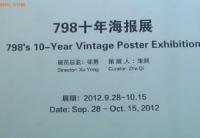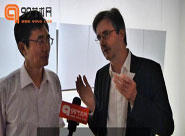The third is about the individualized expression of works. If the communication between the experience of life and that of survival is the basis for the existence of individualization in artistic creation, then the turns in Luo Jie’s life are the causes of his unique expression. After graduation, Luo Jie went to the South for a living by himself. The result is imaginable. In Shenzhen at the early 1990s, people’s material desires were swelling, and even the air smelt of the stink of money. After hard labor every day, Luo Jie would not have any relationship with this city; instead, he buried himself in books and tried to find comfort from them. It was just during this period that Luo Jie formed the habit of writing and independent thinking. And he also benefited from the seemingly monotonous work—that is, he developed a skillful command of the features of painting pigments. What Luo Jie used in his work--imported Dutch pigments and Japanese animation paper—was bona fide luxury products for him. But the strange environment also made him extremely lonely. He even showed symptoms of melancholia. In 1993, Luo Jie came back to the Southwest with 20,000 yuan in hand, still dreaming of becoming an artist! In Chongqing, he met He Sen and spent some time painting together. Then he came to Chengdu. Two years passed in a flash. When Luo Jie used up all his savings and could no longer afford the basic expenses for painting, he had to move to stay temporarily near the Du Fu Thatched Cottage in Chengdu and support himself by paining some petty works, with no stable sustenance. Luo Jie was reluctant to throw away the waste paper and he would sketch and scratch on it once and once again. It was not until one day did he suddenly realize that there was great similarity between the lines and the fishnets his father had once knotted. This abrupt awakening of memory inspired him all at once.
Luo Jie’s father was a man of loneliness, goodness but hot temper. He has been guarding the Amuke watercourse shift on Qinghai-Tibet Plateau all his life as a maintaining worker of National Highway No. 318 in Hongyuan County. He often wove fishing net, went fishing and sold fish to earn more money to support his remote family. Unfortunately, his father was hurt by a truck on the way to fishing by bike and he could not stand up any longer. Thus, the solitary “Prisoner” went back to his home. Luo Jie used to see him sitting in the court and weaving fish nets on the chair. His father seemed forgetting how to communicate with the family due to long period away from the family. Weaving fishing net was a kind of life style without expressing and was the only bailment and consolation of existence of the life. The self-abasement and hard-nosed father felt calm in spirit only when weaving fishing net. The fishing net that can’t be completed forever involved in the life of his father and left permanent memory to Luo Jie as a heavy burden in Luo Jie’s life.
Thus, an endless-winding fishing thread appeared in Luo Jie’s works. This is his series of works named Imprisonment. On one hand, the image language took on negative psychological implication full of ugly, destruction and avulsion visually. On the other hand, the strong desire for mending in the deep mind of Luo Jie broke out unconsciously. The father’s pursuit for love was reflected from endless weaving of fishing net. The practical function of the fishing net was not the most important for him. When Luo Jie created his work by weaving the confused and complicated threads, he mended the unforgettable pain. Unlike his father’s static mending, Luo Jie dynamically mended the pain by placing the artist individual experience and suffering in a historical time dimension and a synchronic space background, considering the historical relations between individuals and the society and reviewing the critical spirit generated from the culture constraints that one must face with in the limited life course. Since 2006, in the series of works named Imprisonment, the rebellious passion and strong scene-like conflicts had been gradually replaced by complex and delicate individualized psychological conflicts, like in such works as the Sensitive Person, the Smoker and Where is the Ivory Tower?, etc. The composition of the images and the depiction of figures are becoming more and more succinct. It can be seen that Luo Jie is more inclined to examine the spiritual problems that contemporary people are facing.
Commented by Zheng Na at Guangdong Museum of Art
April 11, 2009
【编辑:小红】

